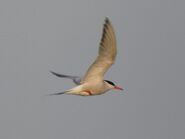| Common Tern | |
|---|---|
 | |
| Scientific classification | |
| Kingdom: | Animalia |
| Phylum: | Chordata |
| Class: | Aves |
| Order: | Charadriiformes |
| Family: | Laridae |
| Genus: | Sterna |
| Species: | Sterna hirundo |
The Common Tern (Sterna hirundo) is a bird in the family Laridae.
Description[]
The nominate subspecies is 31 to 35 cm long and weighs around 110 to 141 g. Common Terns are overall pale grey seabirds with a black cap. In the breeding season, the fully black cap on the adults extend to the neck and their bellies are greyish. The upper wing coverts have a darker grey scheme than its mostly white scheme of the body plumage. The dark trailing on the wingtips is well noticed in flight. The black bar across the shoulder coverts of the wings, known as the carpal bar, is most visible in nonbreeding adults, immature and juvenile birds. The foreheads of nonbreeding adult birds are mostly white and the black cap is less pronounced than it is in the breeding season. The bill is slender, straight and, in the breeding season, mostly reddish with a dark tip. The bills of nonbreeding adults turn blacker as winter progresses. The back of juveniles has a brownish wash on it and the partial black cap extends to the crown. The bills have a more orangish and blackish scheme in juveniles, non-breeding adults and immature birds. The tail is fork-shaped and mostly has a whitish scheme.
Voice[]
The Common Tern is a very noisy bird. Unusual, hoarse calls include a harsh, raspy "kree-aar", "ki-ki-ki".
Behaviour[]
Feeding[]
The Common Tern feeds primarily on small fish and, occasionally, on other aquatic organisms such as small crustaceans.
Breeding[]
The breeding season begins in late May and ends around late July. During courtship, the male and the female fly above their nesting site, before slowly descending. Once on the ground, the male approaches the female and, with his wings spread and bill pointed downwards, offers her food. The Common Tern nests on sandy or muddy ground. The nest, consisting of a scrape on the ground lined with plant material, is often concealed in halophyte vegetation. The female lays a single clutch of 2-5 eggs per year. The eggs, olive-green, beige or light blue with dark mottling, are incubated by both sexes for about 22-23 days. The young, semi-precocial, are reared by both parents and fledge at the age of 4 weeks.
Distribution and Habitat[]
Common Terns are common in Europe except for the extreme north. They're also present in a large part of Siberia, Anatolia, the Middle East, partly in Central Asia and Mongolia as well as in North Africa and the eastern parts of North America. In winter, the Common Tern migrates to the south and west of Africa, to New Guinea, the Philippines, nearby islands and South America. There are some smaller and volatile colonies in West Africa, specifically in Nigeria and Guinea-Bissau, which are within the area used by other terns for wintering. Common Terns mainly live near rivers, lakes and on the shores of the sea, preferring sandy and saline shores.



